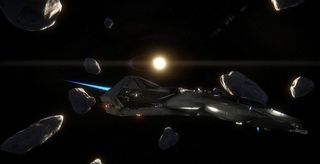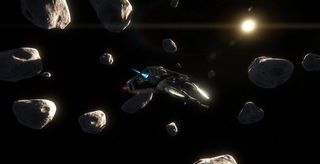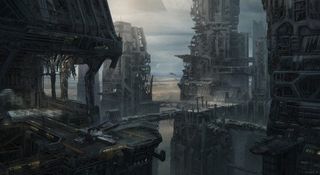Star Citizen interview with Chris Roberts - new concept art and in-engine screenshots

Star Citizen is one of the most ambitious games in development—a massive, high-fidelity, multiplayer space combat sim headed by Wing Commander creator Chris Roberts. Back at GDC I interviewed Roberts about how he plans to realize Star Citizen's prodigious goals, the latest development update—which details modular ship customization —and how the universe as a whole will be simulated. You probably also want to scroll down for the first in-engine screenshots since the prototype reveal.
PC Gamer: You recently posted an update on ship customization , and it all sounds great—especially component tweaking—but this question keeps coming up, which is: “That sounds amazing, but how the hell are they going to do it?”
Chris Roberts: Well, first of all, people haven't really been working on space sim games like this, so some of this stuff is easier—especially now, it's much easier than it was ten years ago, because of the tool sets we're using. Like the ship system we documented, we already have it functioning in the game and in the engine.
"There's no way this game is ever going to survive by us generating scripted content."
That was more a modular design approach, and computers are very good at doing that kind of stuff. And I also think it's the focus of the design of Star Citizen—I'm putting a lot of focus on how to design systems versus more scripted kind of events. There's no way this game is ever going to survive by us generating scripted content, so my goal is to have something like 80 percent of the actual action and drama, whatever you want to call it, be generated by the players themselves. They're hiring each other for missions, they're fighting each other, helping each other out, so we're really trying to make a sandbox that lets people take these roles on and do their own stuff.
So that philosophy extends all the way down to the ship component design, so you can add on these different components, and depending on how you set them up you can set your ship up for dogfighting, or stealth, or you know, hauling cargo. I'm thinking about how I can design a system that will keep people busy for years.

We're also trying to be smart about what we do. There's a lot of high-yield stuff you can do that seems like it has a lot of impact, but isn't necessarily a ridiculous amount of work, and the ship systems is a pretty good example of that. It took us maybe two weeks, three weeks to code up the basic system that it runs under, and we're refining and tweaking it and stuff. So I would say we're doing a good job of delivering some high-yield stuff that's system-based.
On the ship design, your document mentioned that the pipes which connect ship systems can be damaged, causing emergent problems. Can you elaborate on what those are?
The biggest gaming news, reviews and hardware deals
Keep up to date with the most important stories and the best deals, as picked by the PC Gamer team.
Well, the way the pipes actually work is that they're data-driven, so designers can actually specify as many pipes as they want. So one could be a data pipe, one could be a heat pipe, one could be a fuel pipe, and there will be different devices that can feed a pipe or need to receive from a pipe.
So, if you need power, you need to be connected to a power pipe and getting enough power through that pipe to run the weapon, or scanner, or whatever it would be. So, if you don't, then it will either not work or work at 10 percent efficiency, or however that device is set up.
And so, there's a whole idea of whether it's data flow, fuel flow, or energy flow, that it's going between these components, so you've got to manage it. Your power plant has to be able to generate enough power—just like a PC, your PSU has to generate enough power to feed your GPU, your CPU, your case fans. So you have to manage that, and certain devices will drain on that power.

And then there's the whole concept of efficiency, and then also when you overclock. So all the devices have a threshold, just like a normal CPU—Intel rates CPUs at this clock speed, but you can usually overclock them. But you don't know whether you can get you i7 ship up to 4.4 or 5 or push it even beyond that. And some chips can, and some can't, because on the yield basis, they just make sure they hit a certain amount. So, we're going to have the items in the game like that. There will probably be some that will have a potential that will be greater than others.
It makes a lot of sense to apply something PC gamers already know—that sense of ownership over their rig. Beyond just owning it, it's the pride of having built and tweaked it.
That literally was a major part of it. I was shocked. We did a survey of users and I think we had about 10,000-plus respond—maybe more, close to 20,000. It's a pretty large sample compared to generally when you do surveys, and 82 percent of them built their own PCs.
I think in PC gamers you've got this sense of—I don't know whether it's the same in car culture where people tweak and tune their cars. So that was actually a big part of the inspiration. In a normal RPG game, it's like your character you customize and the armor and whatever, and yes we're going to have a little bit of that, but really it's your spaceship.
We also don't have that traditional leveling, where it's like “OK, I'm going to go up to strength 20 now, and 19 dexterity, or whatever it would be.” So, having these different devices and maybe you searching out—like someone's going, “Oh, this device is steady at 30 percent overclocked.” And there will be a few out there, but they won't be very common. So when you get a couple devices and try to overlcock them, if you push them too far they'll damage, but if you've got one of those ones that works at plus 30 percent, that gives you an edge in combat over someone else at stock speed or even plus 10. So on the trading market it will be pretty valuable.

So is the overclock threshold randomized stat? Like with actual chips, some may not be able to be pushed past their rating.
Yeah, exactly. That is 100 percent the inspiration for it, because people go through and they'll bin stuff. They're like, "Oh, I can't get this up, so let me try this other CPU." So that's the idea, and it's to give people things to do and tweak on their ship.
I could definitely see someone just staying with the same ship—the analogy is it's the case in a PC, and completely changing the components out. And I actually see that people would basically have different sets of components, and we're going to let them have buildouts. So when you go into your hanger, you could have your dogfighting build out, or your stealth buildout, you know, something else you could be doing in the game is you could be an information courier. So there's some remote areas of the galaxy that aren't on the regular relay comm system, so getting news from there is difficult. So, as a courier you're set up for speed, a certain level of stealth, shielding, making sure your units are all cool.
On the next page: How Roberts plans to simulate a universe, and an update on development progress.

Tyler grew up in Silicon Valley during the '80s and '90s, playing games like Zork and Arkanoid on early PCs. He was later captivated by Myst, SimCity, Civilization, Command & Conquer, all the shooters they call "boomer shooters" now, and PS1 classic Bushido Blade (that's right: he had Bleem!). Tyler joined PC Gamer in 2011, and today he's focused on the site's news coverage. His hobbies include amateur boxing and adding to his 1,200-plus hours in Rocket League.
Most Popular






